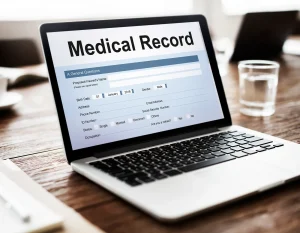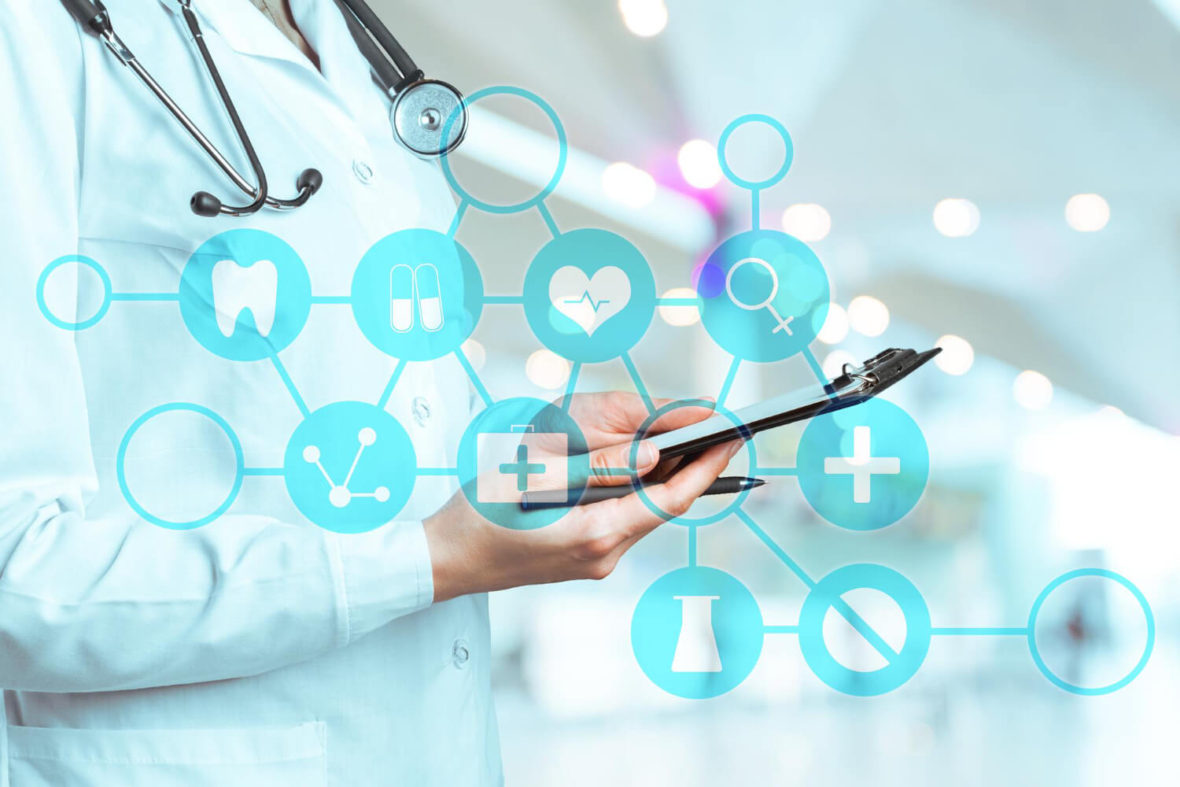
EMR and EHR medical abbreviations are often used interchangeably. However, there are some key differences that are especially important for those working in a pharmacy setting. In this quick guide, we’ll define EHR and EMR medical abbreviations thoroughly to help you understand the differences, and delve into the details of which can benefit your pharmacy most.
What is an EMR?
Let’s start with the basics: what does EMR stand for, and what is EMR data used for?
An EMR is an Electronic Medical Record. Put simply, it’s a digital version of the information you’d find on a patient’s chart, whether you’re keeping it on paper or through other documentation methods (like trying to piece together information within your pharmacy dispensing system). Primarily used for evaluation and treatment, utilizing EMRs helps providers and their practices by facilitating better communication and coordination between a patient’s healthcare team to improve outcomes.
The patient details you’ll find on an EMR would typically include the following:
- Medical history
- Diagnoses
- Medications
- Lab results
- Immunization records
- Allergies
- Provider notes
But what is EMR used for? The advantages of having digital medical records include easier patient tracking and monitoring, and the ability to quickly and easily identify which patients are due for follow-ups, preventative screenings, and the like. Plus, with digital patient data, privacy and security are enhanced, and there are fewer errors in each patient’s medical record. The downside is that data doesn’t transmit easily to other healthcare providers outside the practice using the same or other EMR systems, meaning they have limited functionality in a pharmacy setting. That’s where EHRs come in.
EMR vs EHR: What’s the Difference?
EHR stands for Electronic Health Record. That may sound like the same thing as an EMR, but there are some significant differences regarding shareability, depth of data, ease of transfer, and general purpose. Let’s take a look at each factor in detail.
Shareability
Electronic health records typically contain the same information as an EMR, but they are shareable between authorized providers, health organizations, clinics, labs, imaging facilities, and pharmacies, etc. With enhanced data sharing between all parties involved in patient care, information can be updated in real-time, making patient experiences more streamlined and efficient. Also, patients have access to their own medical records when providers utilize an EHR over an EMR, meaning they can be more engaged in their healthcare journeys.
Depth of Data
More comprehensive information can be provided when organizations utilize an EHR, meaning medical personnel at every patient contact point can access data to improve the service they provide and coordinate care more efficiently.
Examples of additional details you’ll find in an EHR vs an EMR include:
- Insurance information
- Demographic data
- Data imported from personal wellness devices
Ease of Transfer
While some patients may stay with the same primary care provider for their lifetime, many will move several times. EHR systems allow patients’ medical information to travel with them, even if they move interstate. The ability to transfer medical records quickly and easily between providers means patients won’t need to suffer interruptions or delays in their healthcare when they move between practices and pharmacies. Their medication and treatment plan information can even be shared before they move, ensuring a smooth transition between providers.
General Purpose
As we’ve already highlighted, EMR systems don’t allow patient records to be shared easily outside an individual practice. So, what is EMR technology’s value if EHR data is both more comprehensive and easier to share? The answer lies in day-to-day functionality.
A single practice may not require enhanced data sharing. The primary purpose from an internal perspective may simply be to digitize records to improve patient flow. And, it’s not impossible for pharmacies to receive information from a practice’s EMR. However, it can be complex and time-consuming — often involving the practice printing and mailing hard copies of patient charts. So, from a pharmacy perspective, EHRs are much more beneficial in coordinating patient care.
Benefits of EHRs
EHRs are often described as the future of healthcare because they facilitate more efficient, patient-centered care. Here is a comprehensive list of benefits to your pharmacy utilizing EHR software.
- Better patient care – Coordinated care between all organizations involved in a patient’s healthcare journey results in better outcomes and reduces the chance of potentially preventable readmissions (PPR).
- Reduced risk – When pharmacists have access to detailed information regarding medical history, they can be proactive in ensuring that patients are on the best treatment regimen and medications they provide won’t lead to adverse drug events.
- Improved patient engagement – Engaged patients play a more active role in their treatment and recovery. EHRs improve patient engagement by enabling secure messaging and input additional data themselves via online questionnaires and home monitoring devices.
- Improved self-care – With EHR software, patients can log on and access their healthcare records anytime to track their progress. For example, they can see trends in lab results over successive months. This can be a significant motivating factor in patients sticking to their medication regime and maintaining healthier lifestyles to sustain improvements and results.
- Improved long-term health – When patients are more involved and can be proactive in monitoring and managing their own health, they are likely to deal with signs and symptoms earlier and seek treatment before illnesses and diseases progress toward chronic stages.
- Cost efficiency – Because EHRs record all lab results, pharmacists can access information at a glance without having to conduct duplicate tests and screenings, like taking blood pressures or completing a lipid panel, to ensure patient medications are achieving the desired outcome.
- Enhanced reporting – EHR systems are searchable, providing easy access to historical data that makes reporting easier. For example, when flu season is approaching, you can project anticipated volume based on historical trends with a few clicks.
- Electronic prescribing – Pharmacists are now authorized to prescribe vaccines and medications in many states. With an EHR, e-prescribing works seamlessly to send medication orders to your pharmacy dispensing system.
- Reduced waste – Pharmacies often print leaflets and pamphlets detailing medication information and self-care instructions. Having access to provider notes and detailed discharge instructions helps reduce waste by providing the specific materials relevant to each patient’s needs.
- Data collection – Quality EHR software proactively prompts users to enter additional information, leading to more thorough, complete, and comprehensive patient records.
- Workflow automation – Because EHR systems automatically organize, interpret, and react to the data stored within them, you can improve your services by setting reminder alerts that streamline your workflows.
- Decision support – EHRs incorporate evidence-based tools to support decisions and can also connect you to other members of the care team for care coordination. Plus, EHR utilizes smart technology that can warn you about potential drug interactions based on a patient’s medical history.
- More efficient administration – EHR technology helps with general practice management by reducing the time you spend searching through physical paperwork. This, in turn, reduces patient wait times and eliminates delays in service. Additionally, patients can use their login portals to schedule appointments, freeing up pharmacists’ time to concentrate on front-line care.
- Improved satisfaction and retention – Patients who are more engaged and receive faster, more efficient in-store service will be happy customers and likely to remain loyal to your pharmacy rather than switching to a competitor.
Power Up Your Pharmacy with DocStation
DocStation can help you store and manage all your electronic health records on one convenient and easy-to-use platform. We specialize in helping pharmacies and health plans collaborate to improve patient engagement, outcomes, and minimize the total cost of care.
Our software can streamline your back office, improve patient flow, and help you optimize customer service and profits simultaneously by:
- Measuring performance and generating the reports you need to track outcomes and quantify return on investment (ROI)
- Managing provider networks by grouping multiple pharmacies as a clinically integrated network
- Submitting and tracking electronic medical claims to any health plan in the country
- Providing billing reimbursement support, ensuring you’ll always get paid for your work.
Ready to work smarter? Contact us to learn more or request your free demo today!





